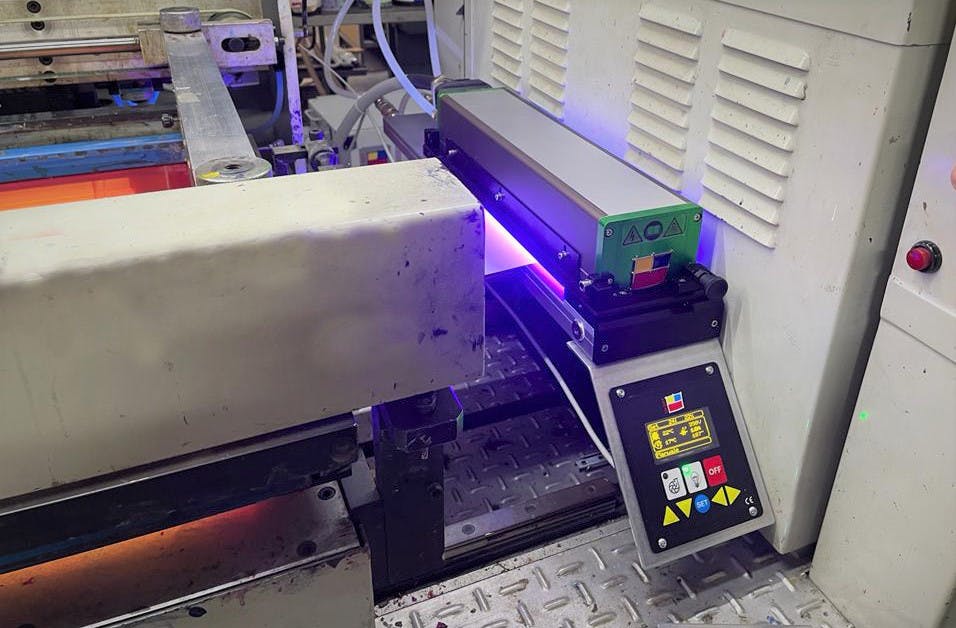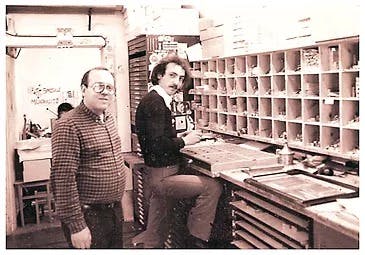UV LED for screen printing labels in Sicily

[Original article from MetaPrintArt translated in to English]
This one by UV RAY at Non Solo Etichette srl is the first installation in Sicily for UV LED treatment on a flat screen printing machine. We talk about it with Calogero Quartana and Alberto Maiano who describe this solution from which the Agrigento-based company has received a decisive boost to establish itself in an evolving market that is increasingly attentive to sustainability as well as quality.
Non Solo Etichette srl in Sciacca (AG) is the classic family print shop, which from the Stella and the flat-cylinder on which founder Vito Quartana worked has grown over time adapting to the typical local Sicilian market: aimed at the processing industries for anchovies, tuna and for preserves and, lately, since 2017, with labels for oil and wine that require more attention to quality and embellishment. Where UV ink printing and, today, UV LED curing dominate.
To better enter these markets and to improve the quality of printing and label embellishment, Calogero Quartana, Vito's son, who since 2017 with the transformation of Non Solo Etichetteinto an Ltd. company, decided to take on the adventure of printing with UV inks on the new screen printing machine, precisely a Sericonvert by Franchini in the 330 format, a standard of screen printing machines.
Calogero had heard that UV RAY is an Italian company that has been appreciated for years for its quality UV LED systems especially in the world of wine labels, so he decided to turn to them to find a solution that would suit his needs.
"They contacted us," Alberto Mariano, owner of UV RAY, tells us, “Knowing that we have installed respectable UV LED systems among offset, screen and even letterpress machines, although this is our first installation in Sicily. When he called us, Calogero Quartana told us that he intended to "improve the quality of labels in screen printing with UV inks," asking if we could help him."Specifically, 'Not Just Labels' prints on a 330 2-color screen-printed Franchini with an inline hot gold unit and die-cut, as well as a 64×44 4-color Shinoara on which it prints cardboard for the cans, and the letterpress machines with which Vito started the printing company, now used to die-cut pharmaceutical and food type cans.
In addition, to increase production it also recently installed a six-color Mida band 250 web press with five letterpress units and one flexo and die-cutting unit in line, to which it added a GMP folder-gluer and laminator, and, to ensure customers a supply without waste errors, a Prati inspection machine. A definite step forward for a small company that until a few years ago printed sheetfed labels on a flatbed press.
In short, from being a small family business, the Sciacca-based company has set out on the path of respectable suppliers for a market that is certainly more demanding today than in the past. As Calogero confirms when we ask if they can extend into new sectors with the inclusion of UV LEDs: "Rather than entering new markets," he tells us, "where we cannot compete with large companies, we think it is better for us to consolidate our current market and build its loyalty. This we can only do by always improving the quality of printing and the prepress and file setting service that we provide to the customer."
"We relied on an experienced provider."
With regard to printing with UV inks, which they had already started using conventional lamps, we had encountered problems with drying because with the heat of the lamps, the materials deformed and in startup the register was lost, thus increasing waste.
"That's why we turned to UV RAY, having learned of their experience with both lamps and now with LEDs. We relied on them and now with UV LEDs from UV RAY we work at low temperature and in startup, after 10 to 15 meters we already go to register ."
He adds, "With traditional UVs you need to keep the lamps on, with the drawback of deformation of the paper and the media you are printing while UV LEDs in downtime turn off and on restart turn on again. Another problem with traditional UV is that when there are full substrates these don't dry well and the hot foil gold doesn't stick."
In short, he seems very satisfied with the choice because he achieved results beyond expectations, thanks to Maiano's suggestions, as he explains.
"I also have to thank Maiano's shrewdness in working with Sun Chemical, because with the new environmentally friendly ink compositions we have achieved results we did not expect and in line with sustainability requirements. And now with LEDs, there are never any spots on the printed surface because they dry evenly."
We turn again to Alberto Maiano to ask how he experienced this new experience in Sicily with this first installation.
"A very positive experience. We met Giuseppe Interrante, a printer, who is attentive and willing to solve as best he can all the production problems that is certainly not trivial."
How was the approach with a new customer who had special needs?
"Giuseppe listened to us and followed all our advice, also because we were able to build on our previous experience, so today he can print without any problem on blank paper or on plastic substrates of all kinds. The very fact that we have a partnership with ink suppliers, such as Sun Chemical but also with Colorgraf and Toka with whom we do testing in our R&D lab, has given us the opportunity to find the best solutions for example even and especially with opaque colors since the wavelength of LEDs greatly improves adhesion on all types of substrates while maintaining a higher surface hardness than traditional UV inks."
But screen printing involves some ink thickness—how does UV LED perform and how were you able to verify that it was good for wine labels?
"This is the first installation on a flat screen web screen printing machine in Sicily, but we were sure it would be fine because we had installed systems on rotary screen printers before," Maiano confirms.
Perfect Curing
Is drying complete? Have you encountered any problems with counterprinting?
Calogero Quartana answers us, "The drying is perfect even if the thicknesses are very high and we have not encountered any backprinting on the roll, the curing is perfect for in-line hot lamination in the next station, without suffering any slowdown in printing speed."
Do you plan to use UV LED on cartons and offset as well?
"UV LED can also be used in carton printing and offset printing although this is a niche market."
What do you expect, in terms of the market, from this solution?
"We expect to convert existing screen printing plants because we have found significant technical, energy and environmental benefits. There is a national regulation, which some apply to the letter and others do not, that prohibits ozone generated by UV lamps from being expelled into the atmosphere. LEDs do not produce ozone, and the LED UV system also requires less energy."
We thank Calogero Quartana and Alberto Maiano for these interesting answers, which we believe could be another step toward more effective and greener screen printing label production.
